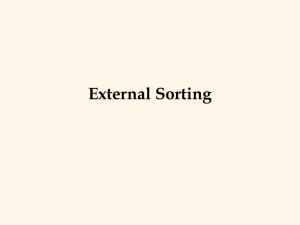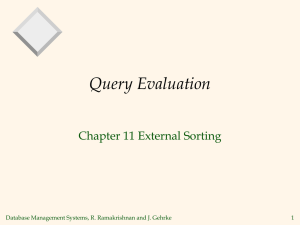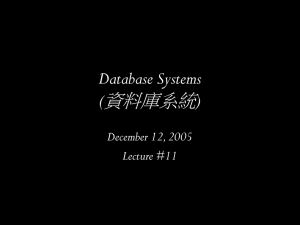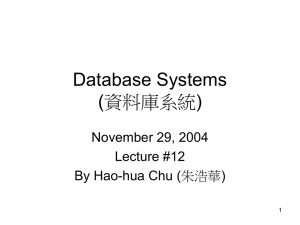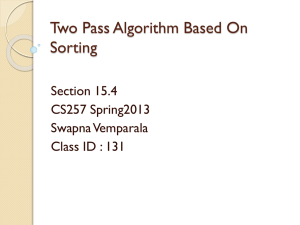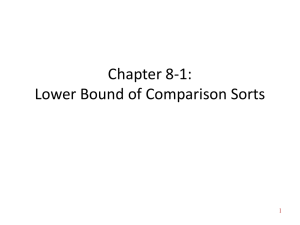pptx
advertisement
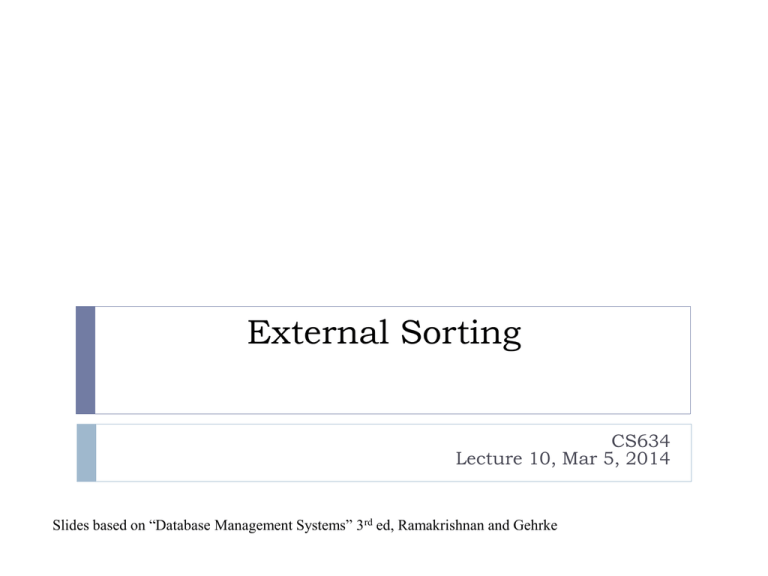
External Sorting CS634 Lecture 10, Mar 5, 2014 Slides based on “Database Management Systems” 3rd ed, Ramakrishnan and Gehrke Why is Data Sorting Important? Data requested in sorted order e.g., find students in increasing gpa order Sorting is first step in bulk loading B+ tree index Sorting useful for eliminating duplicate copies Needed for set operations, DISTINCT operator Sort-merge join algorithm involves sorting Problem: sort 1Gb of data with 1MB of RAM, or 10MB Sort is given a memory budget, can use temp disk as needed Focus is minimizing I/O, not computation as in internal sorting 2-Way Sort: Requires 3 Buffers Pass 1: Read a page, sort it, write it only one buffer page is used Pass 2, 3, …, etc.: three buffer pages used INPUT 1 OUTPUT INPUT 2 Disk Main memory buffers Disk Two-Way External Merge Sort 3,4 6,2 9,4 8,7 5,6 3,1 2 3,4 2,6 4,9 7,8 5,6 1,3 2 4,7 8,9 2,3 4,6 1,3 5,6 Input file PASS 0 1-page runs PASS 1 2 2-page runs PASS 2 2,3 4,4 6,7 8,9 1,2 3,5 6 4-page runs PASS 3 1,2 2,3 3,4 4,5 6,6 7,8 9 8-page runs Two-Way External Merge Sort Each pass we read + write each page in file. Number of pages N in the file determines number of passes Ex: N = 7, round up to power-of-two 8 = 23, #passes = 4 (last slide) Here 3 = log2 8 = ceiling(log2 7), so 4 = ceiling(log2 N) + 1 Total number of passes is, using ceiling notation: log2 N 1 Total cost is: write & read all N pages for each pass: 2N log2 N 1 General External Merge Sort More than 3 buffer pages. How can we utilize them? To sort a file with N pages using B buffer pages: Pass 0: use B buffer pages. Produce N / B sorted runs of B pages each. Pass 2, …, etc.: merge B-1 runs. INPUT 1 ... INPUT 2 ... OUTPUT ... INPUT B-1 Disk B Main memory buffers Disk Cost of External Merge Sort Number of passes: 1 log B 1 N / B Cost = 2N * (# of passes) Example: with 5 buffer pages, sort 108 page file: Pass 0: 108 / 5 = 22 sorted runs of 5 pages each (last run is only 3 pages) Pass 1: 22 / 4 = 6 sorted runs of 20 pages each (last run is only 8 pages) Pass 2: ceiling(6/4) = 2 sorted runs, 80 pages and 28 pages Pass 3: Sorted file of 108 pages Note 22 rounds up to power-of-4 64 = 43 so we see 3 passes of merging using (up to) 4 input runs, each with one input buffer Cost of External Merge Sort, T2 of last class Number of passes: Cost = 2N * (# of passes) Example: with 5 buffer pages, sort 250 page file: 1 log B 1 N / B Pass 0: ceiling(250/5) = 50 sorted runs of 5 pages each Pass 1: ceiling(50/4) = 13 sorted runs of 20 pages each (last run is only 10 pages) Pass 2: ceiling(13/4) = 4 sorted runs, 80 pages and 10 pages Pass 3: Sorted file of 250 pages Note 50 again rounds up to power-of-4 64 = 43 so we see 3 passes of merging using (up to) 4 input runs, each with one input buffer But 50 is getting up in the vicinity of 64, where we start needing another pass Number of Passes of External Sort N B=3 B=5 100 7 4 1,000 10 5 10,000 13 7 100,000 17 9 1,000,000 20 10 10,000,000 23 12 100,000,000 26 14 1,000,000,000 30 15 B=9 3 4 5 6 7 8 9 10 B=17 B=129 B=257 2 1 1 3 2 2 4 2 2 5 3 3 5 3 3 6 4 3 7 4 4 8 5 4 Example of a Blocked I/O Sort Example: N=1M blocks, B=5000 blocks memory for sort Use 32 blocks in a big buffer, so have 5000/32 = 156 big buffers File is 1M/32 = 31250 big blocks Pass 0: sort using 156 big buffers to first runs: get ceiling(31250/156) = 201 runs Pass 1: merge using 155 big buffers to 2 runs Pass 2: merge 2 runs to final result See 3 passes here, vs. 2 using “optimized” sort, pg. 431 Cost = 2N*3 = 6N, vs. 4N using ordinary blocks But I/O is 4ms vs. (5/32)ms, so 6*(5/32)=1 vs. 4*4 = 16, a win. Double Buffering To reduce wait time for I/O request to complete, can prefetch into `shadow block’ Potentially, more passes; in practice, most files still sorted in 2-3 passes INPUT 1 INPUT 1' INPUT 2 INPUT 2' OUTPUT OUTPUT' b Disk INPUT k block size INPUT k' B main memory buffers, k-way merge Disk Prefetching, tuning i/o Note this is a general algorithm, not just for sorting Can be used for table scans too Database have I/O related parameters Oracle: DB_FILE_MULTIBLOCK_READ_COUNT Says how many blocks to read at once in a table scan Using B+ Trees for Sorting Scenario: Table to be sorted has B+ tree index on sorting column(s). Idea: Can retrieve records in order by traversing leaf pages. Is this a good idea? Cases to consider: B+ tree is clustered B+ tree is not clustered Good idea! Could be a very bad idea! (Already existent) Clustered B+ Tree Used for Sorting Cost: root to the left-most leaf, then retrieve all leaf pages (Alternative 1) If Alternative 2 is used, additional cost of retrieving data records: each page fetched just once Index (Directs search) Data Entries ("Sequence set") Data Records Always better than external sorting! Unclustered B+ Tree Used for Sorting Alternative (2) for data entries; each data entry contains rid of a data record. In general, one I/O per data record! Index (Directs search) Data Entries ("Sequence set") Data Records External Sorting vs. Unclustered Index N 100 1,000 10,000 100,000 1,000,000 10,000,000 Sorting p=1 p=10 p=100 200 2,000 40,000 600,000 8,000,000 80,000,000 100 1,000 10,000 100,000 1,000,000 10,000,000 1,000 10,000 100,000 1,000,000 10,000,000 100,000,000 10,000 100,000 1,000,000 10,000,000 100,000,000 1,000,000,000 • p: # of records per page (p=100 is the more realistic value) • B=1,000 and block size=32 for sorting

